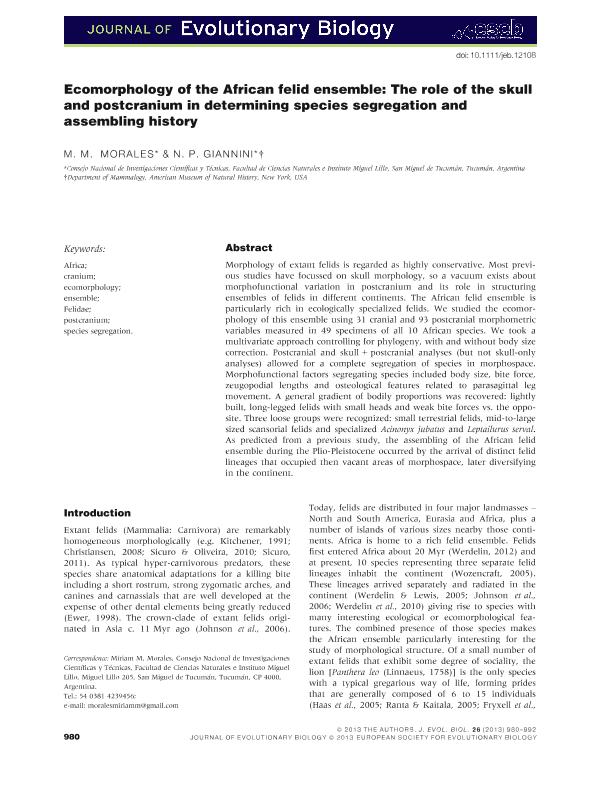Mostrar el registro sencillo del ítem
dc.contributor.author
Morales, Miriam Mariana

dc.contributor.author
Giannini, Norberto Pedro

dc.date.available
2016-08-17T21:30:33Z
dc.date.issued
2013-01
dc.identifier.citation
Morales, Miriam Mariana; Giannini, Norberto Pedro; Ecomorphology of the African felid ensemble: the role of the skull and postcranium in determining species segregation and assembling history; Wiley; Journal Of Evolutionary Biology; 26; 5; 1-2013; 980–992
dc.identifier.issn
1010-061X
dc.identifier.uri
http://hdl.handle.net/11336/7216
dc.description.abstract
Morphology of extant felids is regarded as highly conservative. Most previous studies have focussed on skull morphology, so a vacuum exists about morphofunctional variation in postcranium and its role in structuring ensembles of felids in different continents. The African felid ensemble is particularly rich in ecologically specialized felids. We studied the ecomorphology of this ensemble using 31 cranial and 93 postcranial morphometric variables measured in 49 specimens of all 10 African species. We took a multivariate approach controlling for phylogeny, with and without body size correction. Postcranial and skull + postcranial analyses (but not skull-only analyses) allowed for a complete segregation of species in morphospace. Morphofunctional factors segregating species included body size, bite force, zeugopodial lengths and osteological features related to parasagittal leg movement. A general gradient of bodily proportions was recovered: lightly built, long-legged felids with small heads and weak bite forces vs. the opposite. Three loose groups were recognized: small terrestrial felids, mid-to-large sized scansorial felids and specialized Acinonyx jubatus and Leptailurus serval. As predicted from a previous study, the assembling of the African felid ensemble during the Plio-Pleistocene occurred by the arrival of distinct felid lineages that occupied then vacant areas of morphospace, later diversifying in the continent.
dc.format
application/pdf
dc.language.iso
eng
dc.publisher
Wiley

dc.rights
info:eu-repo/semantics/openAccess
dc.rights.uri
https://creativecommons.org/licenses/by-nc-sa/2.5/ar/
dc.subject
Africa
dc.subject
Cranium
dc.subject
Ecomorphology
dc.subject
Ensemble
dc.subject
Felidae
dc.subject
Postcranium
dc.subject
Species Segregation
dc.subject.classification
Biología

dc.subject.classification
Ciencias Biológicas

dc.subject.classification
CIENCIAS NATURALES Y EXACTAS

dc.title
Ecomorphology of the African felid ensemble: the role of the skull and postcranium in determining species segregation and assembling history
dc.type
info:eu-repo/semantics/article
dc.type
info:ar-repo/semantics/artículo
dc.type
info:eu-repo/semantics/publishedVersion
dc.date.updated
2016-08-11T19:38:47Z
dc.journal.volume
26
dc.journal.number
5
dc.journal.pagination
980–992
dc.journal.pais
Estados Unidos

dc.journal.ciudad
Hoboken
dc.description.fil
Fil: Morales, Miriam Mariana. Universidad Nacional de Tucumán. Facultad de Ciencias Naturales E Instituto Miguel Lillo; Argentina. Consejo Nacional de Investigaciones Científicas y Técnicas. Centro Científico Tecnológico Tucumán; Argentina
dc.description.fil
Fil: Giannini, Norberto Pedro. Universidad Nacional de Tucumán. Facultad de Ciencias Naturales e Instituto Miguel Lillo; Argentina. Consejo Nacional de Investigaciones Científicas y Técnicas. Centro Científico Tecnológico Tucumán; Argentina
dc.journal.title
Journal Of Evolutionary Biology

dc.relation.alternativeid
info:eu-repo/semantics/altIdentifier/url/http://onlinelibrary.wiley.com/doi/10.1111/jeb.12108/abstract
dc.relation.alternativeid
info:eu-repo/semantics/altIdentifier/doi/10.1111/jeb.12108
dc.relation.alternativeid
info:eu-repo/semantics/altIdentifier/doi/http://dx.doi.org/10.1111/jeb.12108
Archivos asociados
